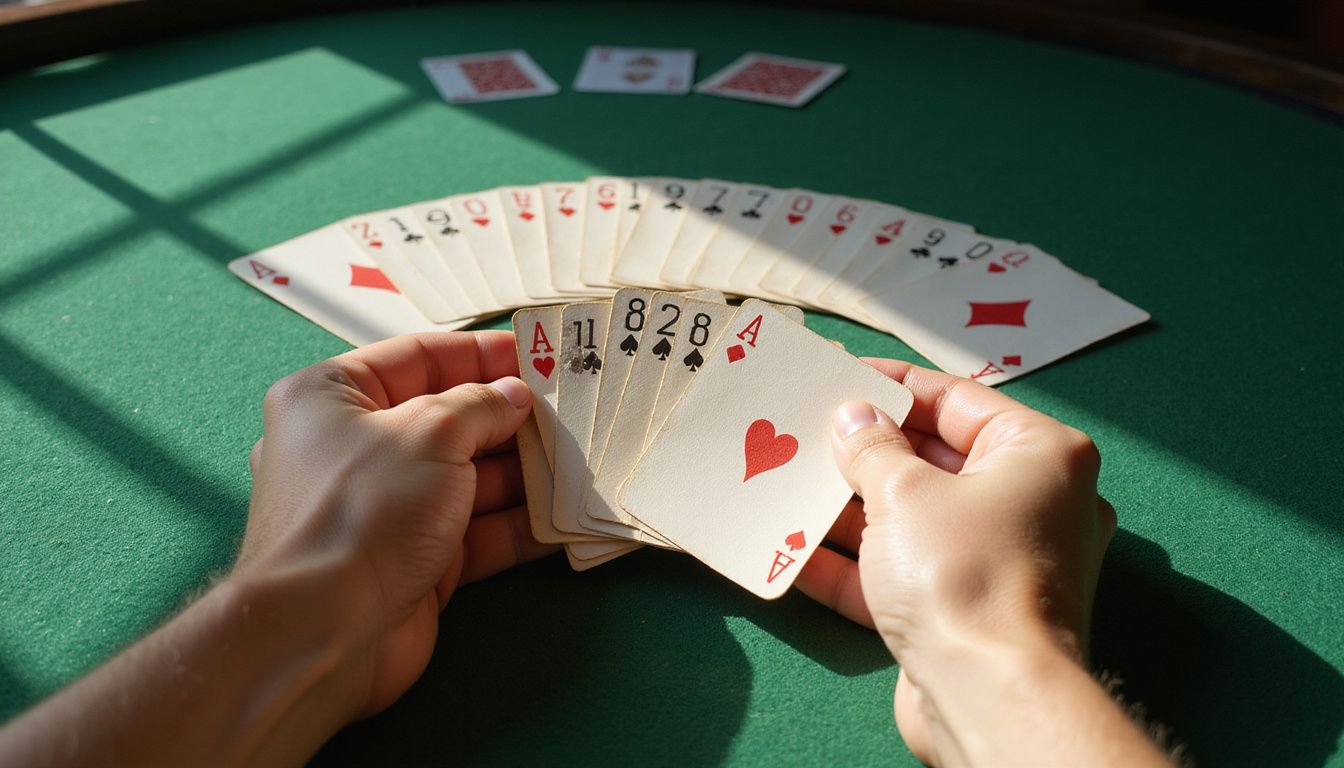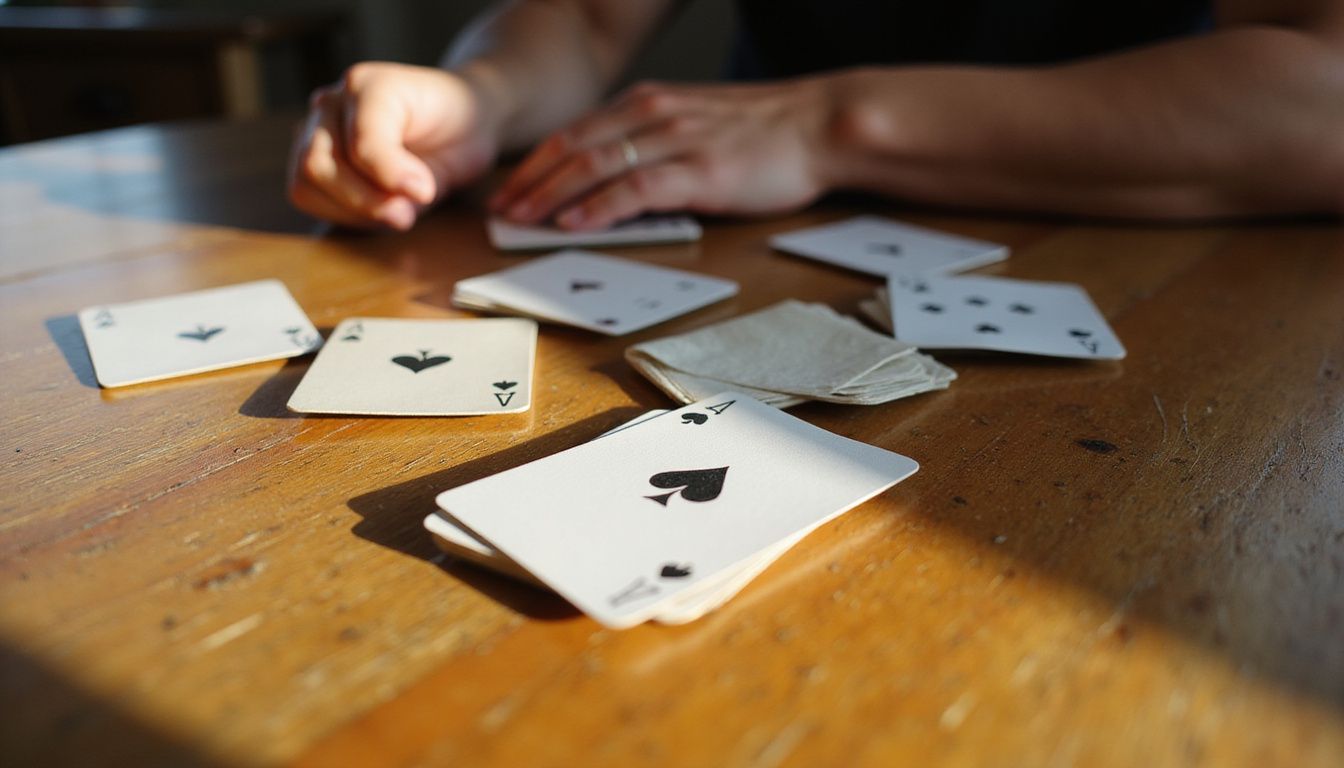Many players lose money at blackjack tables because they misplay soft hands. A soft hand contains an Ace that counts as 11 without busting, giving you a huge advantage over hard hands.
This guide will teach you the exact blackjack strategy for soft hands that can lower the house edge and boost your winning chances. Learn when to hit, stand, or double down with confidence.
Understanding Soft Hands in Blackjack

Soft hands in blackjack give players a major edge at the table. A soft hand contains an Ace that counts as 11 without going over 21, creating a flexible hand that cannot bust on the next hit.
This special quality makes soft hands less risky than hard hands. The Ace can switch between values of 1 and 11 as needed, which opens up more strategic options for players. I’ve seen many players miss these chances by treating soft hands like hard ones.
The true art of blackjack lies in knowing when to be aggressive with your soft hands.
Soft hands range from A-2 (soft 13) through A-9 (soft 20), with each requiring different basic strategy moves. For example, soft 13-14 hands should almost always be hit, while standing becomes the right play with soft 18 or higher.
Dealer upcards greatly affect these decisions too. The flexibility of soft hands creates perfect spots for doubling down, especially against dealer’s weak cards showing 3 through 6.
Let’s explore the exact basic strategy moves for different soft hand situations.
Basic Strategy for Soft Hands
Basic Strategy for Soft Hands guides your decisions at the blackjack table when holding an Ace. You’ll learn specific rules for hitting, standing, and doubling down that maximize your edge against the dealer.
When to Hit or Stand
Knowing when to hit or stand with soft hands gives you a big edge at the blackjack table. Your chances of winning improve greatly when you make the right moves with these flexible hands.
- Hit soft 13-14 against any dealer upcard since you cannot bust with one card. The Ace’s dual value gives you this safety net in basic strategy play.
- Hit soft 15-16 when the dealer shows 7 or higher. The dealer has a strong chance of making 17+ with these upcards, so you need a stronger hand to compete.
- Stand on soft 18 if the dealer shows 2, 7, or 8. Your 18 is good enough to win against these dealer cards according to basic strategy charts.
- Hit soft 18 if the dealer shows 9, 10, or Ace. The dealer has a high chance of making 19 or better, making your 18 likely to lose.
- Double down on soft 13-17 when the dealer shows a 5 or 6. The dealer has a high chance of busting with these weak upcards.
- Always stand on soft 19 or higher no matter what card the dealer shows. These hands are strong enough to win most rounds without taking more cards.
- Hit soft 17 against a dealer’s 7 through Ace. Your hand isn’t strong enough to win against the dealer’s likely strong hand.
- Stand on soft 17 against dealer’s 2 through 6. The dealer has a good chance of busting with these upcards, so protect your decent hand.
- Count cards to adjust your soft hand strategy in multi-deck games. Card counting systems help you know when to deviate from basic strategy.
- Learn the specific rules for the blackjack table game you’re playing. House rules can change optimal soft hand play in online blackjack versus live games.
Doubling Down Rules for Soft Hands
Doubling down with soft hands gives players a powerful edge at the blackjack table. The flexible nature of soft hands makes them perfect for aggressive play when the dealer shows weakness.
- Double down on soft 13 or 14 when the dealer shows a 5 or 6 upcard. This move takes advantage of the dealer’s weak position while using your Ace’s flexibility.
- Always double on soft 15 or 16 against dealer upcards of 4, 5, or 6. Card counters know this play increases your profit over time in multi-deck games.
- Double down on soft 17 against dealer upcards of 3 through 6. Your hand has enough strength to win more often, and you can’t bust on the next card.
- Double on soft 18 against dealer upcards of 3 through 6 in basic strategy play. The math proves this action yields better results than simply standing.
- Never double soft 19 or higher in most blackjack games. These hands are already strong enough to stand on according to basic strategy charts.
- Adjust your doubling strategy based on table rules. Single-deck games may offer different doubling opportunities than multi-deck blackjack.
- Double down more aggressively in games that allow doubling after splitting pairs. This rule increases your chances to maximize profit on strong starting hands.
- Consider the dealer’s upcard as your main factor in doubling decisions. Weak dealer cards (4-6) create the best doubling situations for your soft hands.
Splitting Pairs with Soft Hands
While doubling down offers great chances to maximize profits, splitting pairs with soft hands adds another layer to your blackjack strategy. Soft hands containing pairs present unique opportunities that smart players can use to their advantage.
- Splitting a pair of Aces creates two soft hands, each starting with 11 points. This move gives you two chances to hit blackjack or strong hands.
- You should always split Aces regardless of the dealer’s upcard, as this basic strategy move greatly improves your winning odds.
- Never split tens, even if one is an Ace (soft 21). A blackjack pays more than any other winning hand.
- The flexibility of soft hands comes from the Ace’s dual value as either 1 or 11 points, making bust risks much lower after splitting.
- Card counting experts pay close attention to soft hands after splits since these hands offer more strategic options.
- Multi-deck blackjack games may have different rules about re-splitting Aces, so check the table rules before playing.
- Players should hit soft 13-14 after splitting if the dealer shows a strong upcard (7 through Ace).
- The basic strategy chart for soft hands still applies after splitting pairs that create soft hands.
- Standing on soft 17 or higher remains the standard play in most situations after a split.
- Dealers must follow fixed rules with no flexibility, giving players with split soft hands a significant advantage.
Soft Hand Strategy Charts
Soft hand strategy charts give you clear rules for every dealer and player card combo, making tough choices easier at the table. Check out our guide to learn how these charts work and see examples that will boost your game right away.
How to Use a Strategy Chart Effectively
Strategy charts serve as your roadmap at the blackjack table. To use one properly, first locate your hand value on the left side of the chart and the dealer’s upcard across the top.
The box where these two lines meet shows your best move. For soft hands like A-5 (soft 16), the chart might suggest different actions than for hard 16. Keep your chart handy until you’ve memorized all moves.
Many casinos allow strategy cards at tables, so don’t hesitate to reference yours during play.
Practice makes perfect with basic strategy charts. Start by focusing on soft hand decisions since they offer more flexibility with the Ace counting as either 1 or 11. Your chart will show exactly when to hit, stand, or double down based on mathematical odds.
For example, with soft 13-14, hitting is usually best since you can’t bust. With soft 18 against a dealer’s 9, 10, or Ace, the chart typically suggests hitting rather than standing.
These strategic moves boost your chances of winning by reducing the house edge.
Key Chart Examples for Soft Hands
Blackjack strategy charts simplify complex decisions for soft hands. These visual guides show the optimal play based on your cards and the dealer’s upcard. The table below presents clear actions for common soft hand scenarios.
| Your Soft Hand | Dealer Shows 2-6 | Dealer Shows 7-8 | Dealer Shows 9-10-A |
|---|---|---|---|
| A,2 (Soft 13) | Hit | Hit | Hit |
| A,3 (Soft 14) | Hit | Hit | Hit |
| A,4 (Soft 15) | Hit | Hit | Hit |
| A,5 (Soft 16) | Hit | Hit | Hit |
| A,6 (Soft 17) | Double Down | Hit | Hit |
| A,7 (Soft 18) | Double Down | Stand | Hit |
| A,8 (Soft 19) | Stand | Stand | Stand |
| A,9 (Soft 20) | Stand | Stand | Stand |
Notice the pattern that soft hands under 17 often require hits. Players should stand on soft 19 and 20 against any dealer card. Soft 18 needs special attention. Double down on this hand against dealer’s weak cards (2-6). The chart shows why soft hands give players an edge. You can make bold moves like doubling down without fear of busting thanks to the Ace’s dual value.
Advanced Tips for Soft Hand Play
Learn how dealer upcards and deck count affect your soft hand decisions – these tips will boost your edge at the tables!
Dealer Upcard Considerations
The dealer’s upcard plays a major role in your soft hand decisions. Weak dealer cards (2-6) signal a good time to double down on soft hands like A-5 through A-7. This works because the dealer has a higher chance of busting with these upcards.
I’ve won many hands at Vegas tables by doubling down on my soft 16 against a dealer’s 5. Strong dealer upcards (7-A) require more caution with your soft hands. The basic strategy chart shows you should hit most soft hands against these cards except soft 18 or higher.
Different casino rules might change these choices slightly, especially in multi-deck blackjack games where card counting becomes more challenging.
Multi-Deck vs. Single-Deck Adjustments
– Multi-Deck vs. Single-Deck Adjustments.
Beyond dealer upcards, the number of decks used changes your soft hand strategy. Single-deck games offer better odds for players compared to multi-deck games. In single-deck blackjack, you should double down more often with soft hands like soft 13-14 against dealer weak cards.
The basic strategy chart shifts slightly because the odds of drawing helpful cards increase with fewer decks.
Card counting works differently across these game types too. Single-deck games make counting more powerful since each card represents a larger percentage of the remaining deck. Your soft hand decisions must adapt to these deck variations.
For example, standing on soft 18 against a dealer’s 9 might be correct in a single-deck game but wrong in an eight-deck shoe. Smart players adjust their basic strategy for soft hands based on the specific game conditions they face.
Conclusion
Mastering soft hands gives you a major edge at the blackjack table. Your flexible Ace creates options that hard hands simply don’t have. Smart players know when to hit, stand, or double down based on their soft total and the dealer’s card.
Practice with strategy charts until these moves become second nature. Soft hands let you play more boldly without fear of busting. Take this knowledge to the casino floor and watch your blackjack profits grow.
FAQs
1. What are soft hands in blackjack?
Soft hands in blackjack are hands that contain an Ace counted as 11. Unlike hard hands, soft hands give players more flexibility since the Ace can switch to a value of 1 if needed to avoid busting.
2. When should I double down with soft hands?
According to blackjack basic strategy, you should double down with soft 17 through soft 18 when the dealer shows a 3 through 6. This play maximizes your profit potential when the dealer is in a weak position.
3. How does basic strategy for soft hands differ in multi-deck blackjack?
Basic strategy chart recommendations for soft hands vary slightly between single and multi-deck blackjack. In multi-deck games, you’ll hit more soft hands against strong dealer cards, while the knockout blackjack system suggests specific adjustments based on the running count.
4. Can card counting improve my soft hand play?
Yes. Card counting creates blackjack deviations from basic strategies when playing soft hands. A positive count rich in ten-value cards often indicates more aggressive doubling opportunities with soft hands that basic strategy might not recommend.
5. Where can I find reliable information about soft hand strategies?
Many blackjack message boards and online threads contain valuable discussions about soft hand play. Look for resources that explain both basic strategy and counting cards techniques specifically for soft hands rather than general blackjack tips.
















